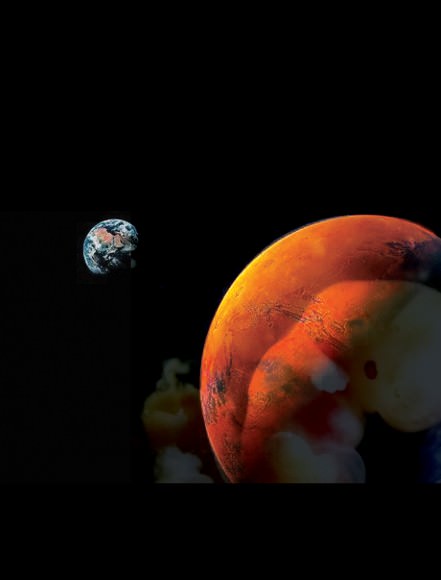Source SPACE.com.
Crystal Rain Cradles Infant Star
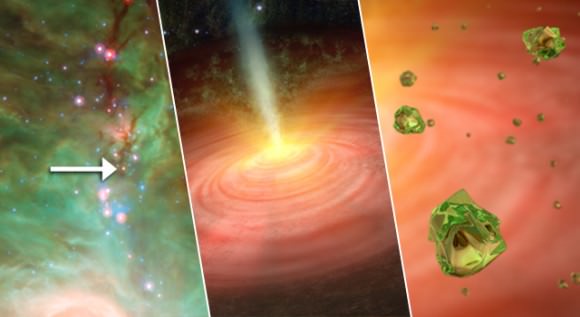
NASA's
Spitzer Space Telescope detected tiny green crystals, called olivine,
thought to be raining down on a developing star. Image credit:
NASA/JPL-Caltech/University of Toledo
Thanks to the infrared
eye of the Spitzer Space Telescope, researchers have captured evidence
of “crystal rain” collapsing around a forming star. These tiny bits of
green mineral – olivine – are also found in meteorites, but it’s the
first time it has been observed in the dusty embryo of the stellar
creation process. While it’s still unclear how these crystals formed,
the suspect may be jets of superheated gas. [click to continue…]
Somewhere
between two and four million years after our solar system formed, a
rocky little runt went through a rapid growth spurt. In its embryonic
stage, it was much like Earth. But it didn’t end up being terrestrial.
Earth ended up being twice its size through collecting other rocky
bodies as they passed by. But not Mars… Oh, no. Not Mars. [click to continue…]

Astronomy Picture of the Day NASA

Thunderbolts Picture of the Day

Spaceweather.com
The
2MASS Redshift Survey (2MRS) has catalogued more than 43,000 galaxies
within 380 million light-years from Earth (z<0.09). In this
projection, the plane of the Milky Way runs horizontally across the
center of the image. 2MRS is notable for extending closer to the
Galactic plane than previous surveys — a region that's generally
obscured by dust.
CREDIT: T.H. Jarrett (IPAC/SSC)
Supernovae
A
supernova is a stellar explosion that is more energetic than a nova.
Supernovae (plural) are extremely luminous and cause a burst of
radiation that often briefly outshines an entire galaxy, before fading
from view over several weeks or months. During this short interval a
supernova can radiate as much energy as the Sun is expected to emit over
its entire life span.
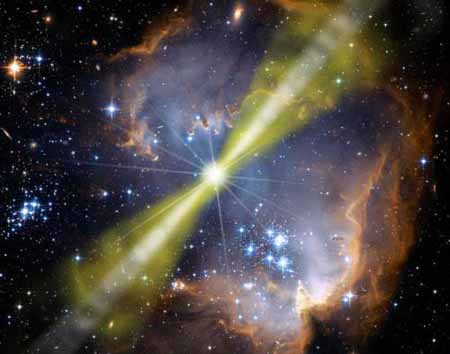

The
explosion expels much or all of a star's material at a velocity of up
to 30,000 kms (10% of the speed of light), driving a shock wave into the
surrounding interstellar medium. This shock wave sweeps up an expanding
shell of gas and dust called a supernova remnant.
Nova (plural
novae) means "new" in Latin, referring to what appears to be a very
bright new star shining in the celestial sphere; the prefix "super-"
distinguishes supernovae from ordinary novae, which also involve a star
increasing in brightness, though to a lesser extent and through a
different mechanism. The word supernova was coined by Swiss
astrophysicist and astronomer Fritz Zwicky, and was first used in print
in 1926.
Several types of supernovae exist. Types I and II can be
triggered in one of two ways, either turning off or suddenly turning on
the production of energy through nuclear fusion. After the core of an
aging massive star ceases generating energy from nuclear fusion, it may
undergo sudden gravitational collapse into a neutron star or black hole,
releasing gravitational potential energy that heats and expels the
star's outer layers.
Alternatively a white dwarf star may
accumulate sufficient material from a stellar companion (either through
accretion or via a merger) to raise its core temperature enough to
ignite carbon fusion, at which point it undergoes runaway nuclear
fusion, completely disrupting it. Stellar cores whose furnaces have
permanently gone out collapse when their masses exceed the Chandrasekhar
limit, while accreting white dwarfs ignite as they approach this limit
(roughly 1.38 times the solar mass).
White dwarfs are also subject
to a different, much smaller type of thermonuclear explosion fueled by
hydrogen on their surfaces called a nova. Solitary stars with a mass
below approximately 9 solar masses, such as the Sun, evolve into white
dwarfs without ever becoming supernovae.
Although no supernova has
been observed in the Milky Way since 1604, supernovae remnants indicate
on average the event occurs about once every 50 years in the Milky Way.
They play a significant role in enriching the interstellar medium with
higher mass elements.
Furthermore, the expanding shock waves from supernova explosions can trigger the formation of new stars.
Observation History
Hipparchus' interest in the fixed stars may have been inspired by the observation of a supernova (according to Pliny).
The
earliest recorded supernova, SN 185, was viewed by Chinese astronomers
in 185 AD. The brightest recorded supernova was the SN 1006, which was
described in detail by Chinese and Islamic astronomers.
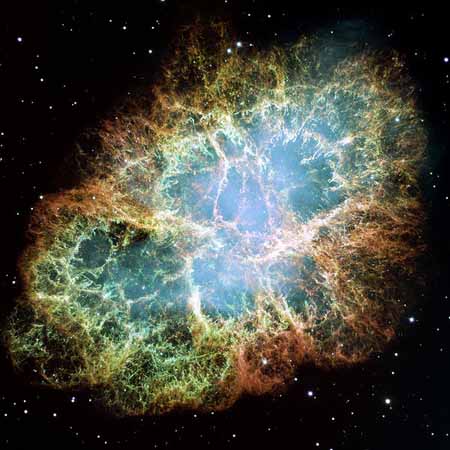
The
widely observed supernova SN 1054 produced the Crab Nebula. Supernovae
SN 1572 and SN 1604, the latest to be observed with the naked eye in the
Milky Way galaxy, had notable effects on the development of astronomy
in Europe because they were used to argue against the Aristotelian idea
that the universe beyond the Moon and planets was immutable.
Johannes
Kepler began observing SN 1604 on October 17, 1604. It was the second
supernova to be observed in a generation (after SN 1572 seen by Tycho
Brahe in Cassiopeia).
Since the development of the telescope the
field of supernova discovery has extended to other galaxies, starting
with the 1885 observation of supernova S Andromedae in the Andromeda
galaxy. Supernovae provide important information on cosmological
distances.
During the twentieth century successful models for each
type of supernova were developed, and scientists' comprehension of the
role of supernovae in the star formation process is growing. American
astronomers Rudolph Minkowski and Fritz Zwicky developed the modern
supernova classification scheme beginning in 1941.
In the 1960s
astronomers found that the maximum intensities of supernova explosions
could be used as standard candles, hence indicators of astronomical
distances. Some of the most distant supernovae recently observed
appeared dimmer than expected. This supports the view that the expansion
of the universe is accelerating.
Techniques were developed for
reconstructing supernova explosions that have no written records of
being observed. The date of the Cassiopeia A supernova event was
determined from light echoes off nebulae,[22] while the age of supernova
remnant RX J0852.0-4622 was estimated from temperature measurements[23]
and the gamma ray emissions from the decay of titanium-44.
In 2009 nitrates were discovered in Antarctic ice deposits that matched the times of past supernova events.
Discovery
Because
supernovae are relatively rare events within a galaxy, occurring about
once every 50 years in the Milky Way, obtaining a good sample of
supernovae to study requires regular monitoring of many galaxies.
Supernovae
in other galaxies cannot be predicted with any meaningful accuracy.
Normally, when they are discovered, they are already in progress. Most
scientific interest in supernovae - as standard candles for measuring
distance, for example - require an observation of their peak luminosity.
It is therefore important to discover them well before they reach their
maximum. Amateur astronomers, who greatly outnumber professional
astronomers, have played an important role in finding supernovae,
typically by looking at some of the closer galaxies through an optical
telescope and comparing them to earlier photographs.
Towards the
end of the 20th century astronomers increasingly turned to
computer-controlled telescopes and CCDs for hunting supernovae. While
such systems are popular with amateurs, there are also professional
installations such as the Katzman Automatic Imaging Telescope.
Recently
the Supernova Early Warning System (SNEWS) project has begun using a
network of neutrino detectors to give early warning of a supernova in
the Milky Way galaxy.Neutrinos are particles that are produced in great
quantities by a supernova explosion, and they are not significantly
absorbed by the interstellar gas and dust of the galactic disk.
Supernova
searches fall into two classes: those focused on relatively nearby
events and those looking for explosions farther away. Because of the
expansion of the universe, the distance to a remote object with a known
emission spectrum can be estimated by measuring its Doppler shift (or
redshift); on average, more distant objects recede with greater velocity
than those nearby, and so have a higher redshift. Thus the search is
split between high redshift and low redshift, with the boundary falling
around a redshift range of z = 0.1-0.3[33] - where z is a dimensionless
measure of the spectrum's frequency shift.
High redshift searches
for supernovae usually involve the observation of supernova light
curves. These are useful for standard or calibrated candles to generate
Hubble diagrams and make cosmological predictions. Supernova
spectroscopy, used to study the physics and environments of supernovae,
is more practical at low than at high redshift. Low redshift
observations also anchor the low-distance end of the Hubble curve, which
is a plot of distance versus redshift for visible galaxies.
Effect on Earth
A
near-Earth supernova is a supernova close enough to the Earth to have
noticeable effects on its biosphere. This would need to be nearer than
about 100 to 3000 light-years away, depending upon type and energy -
different figures have been suggested.
Gamma rays from a supernova
would induce a chemical reaction in the upper atmosphere converting
molecular nitrogen into nitrogen oxides, depleting the ozone layer
enough to expose the surface to harmful solar and cosmic radiation. This
has been proposed as the cause of the Ordovician-Silurian extinction,
which resulted in the death of nearly 60% of the oceanic life on Earth.
In
1996 it was theorized that traces of past supernovae might be
detectable on Earth in the form of metal isotope signatures in rock
strata. Iron-60 enrichment was later reported in deep-sea rock of the
Pacific Ocean.
In 2009, elevated levels of nitrate ions were found
in Antarctic ice, which coincided with the 1006 and 1054 supernovae.
Gamma rays from these supernovae could have boosted levels of nitrogen
oxides, which became trapped in the ice.
Type Ia supernovae are
thought to be potentially the most dangerous if they occur close enough
to the Earth. Because these supernovae arise from dim, common white
dwarf stars, it is likely that a supernova that can affect the Earth
will occur unpredictably and in a star system that is not well studied.
One theory suggests that a Type Ia supernova would have to be closer
than a thousand parsecs (3300 light-years) to affect the Earth.
The
closest known candidate is IK Pegasi. Recent estimates predict that a
Type II supernova would have to be closer than eight parsecs (26
light-years) to destroy half of the Earth's ozone layer.
Several
large stars within the Milky Way have been suggested as possible
supernovae within the next million years. These include Rho Cassiopeiae,
Eta Carinae, RS Ophiuchi, U Scorpii, VY Canis Majoris, Betelgeuse,
Antares, and Spica. Many Wolf-Rayet stars, such as Gamma Velorum, WR
104, and those in the Quintuplet Cluster, are also considered possible
precursor stars to a supernova explosion in the 'near' future.
The
nearest supernova candidate is IK Pegasi (HR 8210), located at a
distance of 150 light-years. This closely orbiting binary star system
consists of a main sequence star and a white dwarf 31 million kilometres
apart. The dwarf has an estimated mass 1.15 times that of the Sun. It
is thought that several million years will pass before the white dwarf
can accrete the critical mass required to become a Type Ia supernova.
Wikipedia
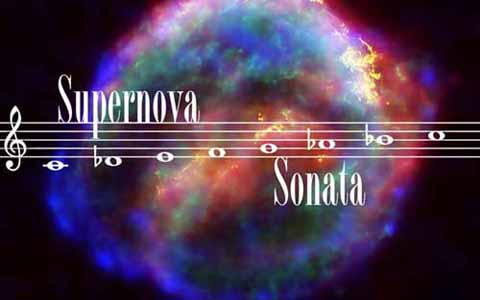
Supernova Sonata NASA - May 26, 2011
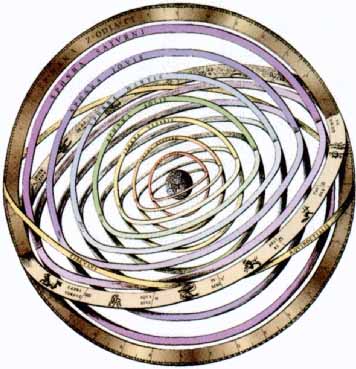
Music of the Spheres
Supernovae in the News ...
Small bangs and white holes PhysOrg - May 23, 2011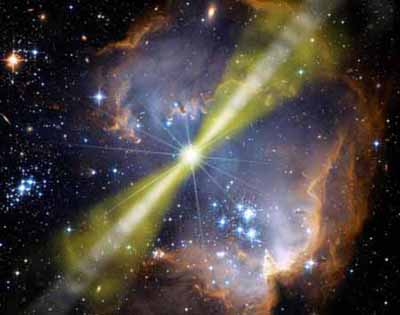
Gamma-ray
bursts. We tend to think of them as big explosions - but it has been
suggested that they might actually be Small Bangs. Most gamma-ray bursts
come in two flavors. Firstly, there are long duration bursts which form
in dense star-forming regions and are associated with supernovae
which would understandably generate a sustained outburst of energy. The
technical definition of a long duration gamma-ray burst is one that is
more than two seconds in duration but bursts lasting over a minute are
not unusual
Image: Galactic super-volcano in action PhysOrg - August 19, 2010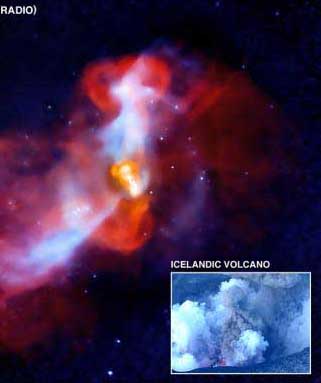
Supernovae mystery solved PhysOrg - July1, 2010
Supernovae
are gigantic stellar explosions that can be seen across the entire
universe. Type 'Ia supernovae' are a relatively homogeneous class of
stellar explosions, which researchers use as 'standard candles' to
observe the acceleration of the universe.
New type of supernova may shed light on some universal mysteries PhysOrg - May 20, 2010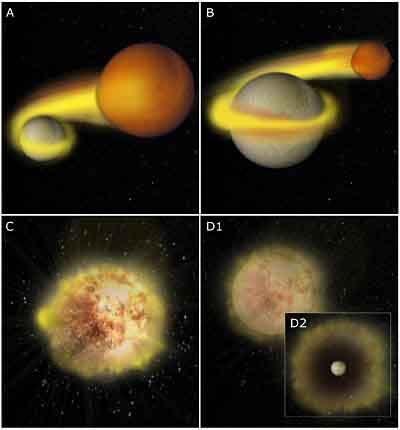
Stellar blast sparks controversy BBC - May 20, 2010
Astronomers have put forward opposing explanations for what could be a new type of exploding star or supernova.
Astronomers discover secret of the supernova Telegraph.co.uk - February 18, 2010
Nasa astronomers may have finally discovered what initially sparks a cosmic explosion, according to new research.
Superbright Supernova Is First of Its Kind Science Daily - December 2, 2009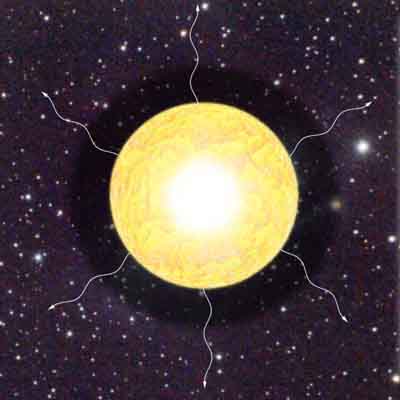
n
extraordinarily bright, extraordinarily long-lasting supernova named SN
2007bi, snagged in a search by a robotic telescope, turns out to be the
first example of the kind of stars that first populated the Universe.
The superbright supernova occurred in a nearby dwarf galaxy, a kind of
galaxy that's common but has been little studied until now, and the
unusual supernova could be the first of many such events soon to be
discovered.
Rapid supernova could be new class of exploding star PhysOrg - November 5, 2009
New Type of Supernova Discovered National Geographic - November 6, 2009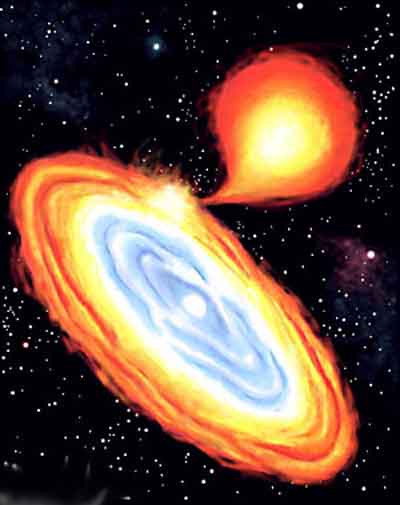
11-Billion-Year-Old Giant Supernovae Farthest Ever Detected PhysOrg - July 8, 2009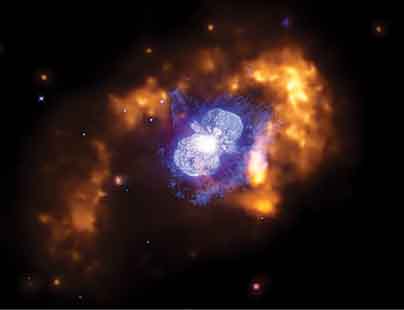
Most Distant Supernovae Found National Geographic - July 8, 2009
 First 3-D Fly-Through of a Supernova Remnant National Geographic - January 7, 2009
First 3-D Fly-Through of a Supernova Remnant National Geographic - January 7, 2009
 Ancient supernova mystery solved BBC - December 4, 2008
Ancient supernova mystery solved BBC - December 4, 2008
Supernova "Shock Breakout" Seen From Red Giant For The First Time National Geographic - June 12, 2008
"Light Echo" Helps Solve Supernova Mystery National Geographic - May 29, 2008
Astronomers
have used an interstellar "mirror" to solve the longstanding mystery
over what kind of supernova created Cassiopeia A, one of the brightest
radio objects in the sky. Cass A, as the object is often called, is the
expanding remains of a stellar explosion about 9,000 light-years away
that is believed to have occurred around A.D. 1680. Until now no one has
been able to pinpoint the exact nature of the blast.
Supernova Caught Starting to Explode for First Time National Geographic - May 21, 2008
A
brilliant burst of light marking a dying star's final moments before
exploding has been glimpsed by astronomers for the first time. Called a
shock breakout, the x-ray flash - detected in January - signals the
destruction of a star several times more massive than our sun.
Brightest Known Supernova Detected National Geographic - October 15, 2007
Enigmatic supernova smashes brightness record New Scientist - October 12, 2007
Supernova blazed like 100 billion suns MSNBC - October 12, 2007
The Brightest Supernova Ever NASA - May 7, 2007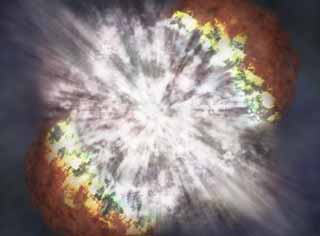
Astrophysicists Explain Differences In Brightness Of Supernova Explosions Science Daily - February 23, 2007
Brightest supernova discovery hints at stellar collision New Scientist - January 4, 2007
Supernova captured in 'real time' BBC - August 30, 2006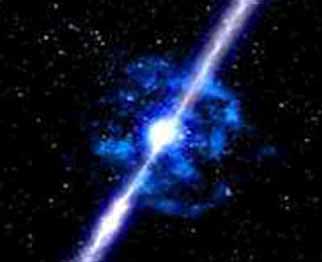
Mystery object found in supernova's heart Space.com - July 7, 2006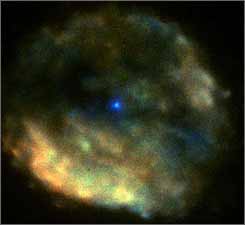
...
energetic X-ray emissions of the blue point-like object cycles every
6.7 hours tens of thousands of times longer than expected for a freshly
created neutron star
Native Americans may have recorded supernova explosion in 1006 AD Space.com - June 6, 2006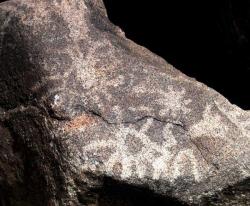
Supernova shock wave creates halo effect New Scientist - August 19, 2005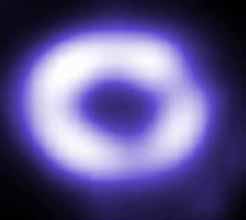
The
shock wave from a bright supernova that exploded in 1987 has now
reached the edge of a cavity around the dead star, reveal new
observations with the Hubble Space Telescope and the Chandra X-ray
Observatory.As intense heat from the shock wave continues to spread, it
will illuminate the dense gas blown off by the detonating star, which
was originally about 20 times more massive than our Sun.Called 1987A,
the supernova was the brightest recorded in 400 years and exploded in a
nearby galaxy called the Large Magellanic Cloud. Astronomers believe
that about a million years before the supernova, the star lost most of
its outer layers through a slow-moving wind of particles.
The Last Supernova - 1604: 400-Year-Old Explosion Imaged - Space.com - October 2004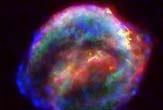
Hubble Reveals Dramatic New Phase of a Supernova Explosion Space.com - February 2004
A
shock wave from an exploding star known as Supernova 1987A lights up
spots in a surrounding ring of dust and gas, in the latest snapshot from
the Hubble Space Telescope. It's the most dramatic stellar explosion
witnessed in centuries - New images from the Hubble Space Telescope show
the dying star's "ring of fire" entering a new phase of brightness
Star Survivor: Companion Endures Explosion Space.com - January 2004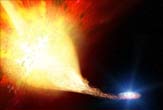
Astronomers
have found a bright blue companion star to an exploded supernova, a
stellar survivor to one of the most violent eruptions in the universe.
Where do supernovae come from? Physics Web - August 2003
Hubble looks at dark Universe BBC - April 2003
Astronomers
using the Hubble Space Telescope have found two distant supernovae -
exploding stars - that provide new clues about the accelerating Universe
and its mysterious "dark energy".
Hubble looks at dark Universe BBC - April 2003
Thanks
to a burster that was remarkably close in cosmic terms, their true
nature may have been revealed. The bursts seem to come from exploding
stars called supernovae.
Astronomers predict stellar explosion for the first time BBC - April 2003
The
star in question is designated Supernova 2003dh and was seen to
brighten on 8 April. The prediction was the consequence of detecting a
pulse of energy in the form of gamma rays from the same direction 10
days earlier. Before this observation, and the prompt given to them by
the gamma-ray burst, scientists could not predict the explosion of a
supernova to an accuracy of better than a few million years.
Hubble looks at dark Universe BBC - April 2003
Astronomers
using the Hubble Space Telescope have found two distant supernovae -
exploding stars - that provide new clues about the accelerating Universe
and its mysterious "dark energy".
Astronomers Discover "Bulls-Eye" Pulsar In Supernova Remnant June 2002 - Science Daily
This
will help scientists better understand how neutron stars channel
enormous amounts of energy into particles moving near the speed of
light.



